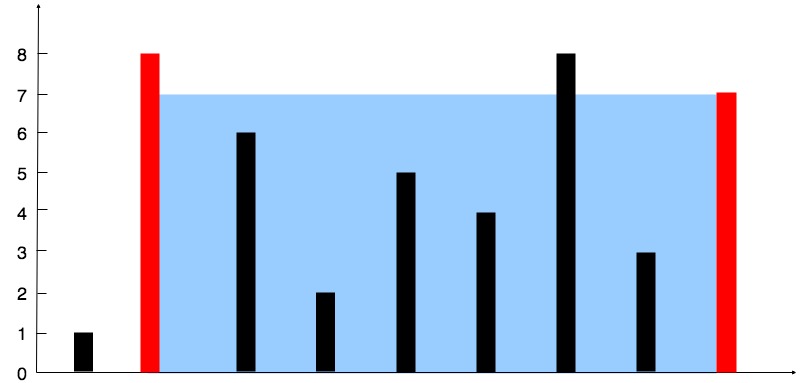You are given an integer array height of length n. There are n vertical lines drawn such that the two endpoints of the ith line are (i, 0) and (i, height[i]).
Find two lines that together with the x-axis form a container, such that the container contains the most water.
Return the maximum amount of water a container can store.
Notice that you may not slant the container.
Example 1:
Input: height = [1,8,6,2,5,4,8,3,7] Output: 49 Explanation: The above vertical lines are represented by array [1,8,6,2,5,4,8,3,7]. In this case, the max area of water (blue section) the container can contain is 49.
Example 2:
Input: height = [1,1] Output: 1
Constraints:
n == height.length2 <= n <= 1050 <= height[i] <= 104
Intuition:
The two-pointer technique starts with the widest container and moves the pointers inward based on the comparison of heights.
Increasing the width of the container can only lead to a larger area if the height of the new boundary is greater. By moving the pointers towards the center, we explore containers with the potential for greater areas.
Explanation:
- Initialize the variables:
leftto represent the left pointer, starting at the beginning of the container (index 0).rightto represent the right pointer, starting at the end of the container (indexheight.size() - 1).maxAreato keep track of the maximum area found, initially set to 0.
- Enter a loop using the condition
left < right, which means the pointers have not crossed each other yet. - Calculate the current area:
- Use the
minfunction to find the minimum height between theleftandrightpointers. - Multiply the minimum height by the width, which is the difference between the indices of the pointers:
(right - left). - Store this value in the
currentAreavariable.
- Use the
- Update the maximum area:
- Use the
maxfunction to compare thecurrentAreawith themaxArea. - If the
currentAreais greater than themaxArea, updatemaxAreawith thecurrentArea.
- Use the
- Move the pointers inward: (Explained in detail below)
- Check if the height at the
leftpointer is smaller than the height at therightpointer. - If so, increment the
leftpointer, moving it towards the center of the container. - Otherwise, decrement the
rightpointer, also moving it towards the center.
- Check if the height at the
- Repeat steps 3 to 5 until the pointers meet (
left >= right), indicating that all possible containers have been explored. - Return the
maxArea, which represents the maximum area encountered among all the containers.
Update the maximum area:
The purpose of this condition is to determine which pointer to move inward, either the left pointer (i) or the right pointer (j), based on the comparison of heights at their respective positions.
Imagine you have two containers represented by the heights at the left and right pointers. The condition checks which container has a smaller height and moves the pointer corresponding to that container.
- If
height[i] > height[j]:- This means that the height of the left container is greater than the height of the right container.
- Moving the right pointer (
j) would not increase the potential area because the height of the right container is the limiting factor. - So, to explore containers with the possibility of greater areas, we need to move the right pointer inward by decrementing
j.
- If
height[i] <= height[j]:- This means that the height of the left container is less than or equal to the height of the right container.
- Moving the left pointer (
i) would not increase the potential area because the height of the left container is the limiting factor. - So, to explore containers with the possibility of greater areas, we need to move the left pointer inward by incrementing
i.
By making these pointer movements, we ensure that we are always exploring containers with the potential for larger areas. The approach is based on the observation that increasing the width of the container can only lead to a larger area if the height of the new boundary is greater.
By following this condition and moving the pointers accordingly, the algorithm explores all possible containers and finds the one with the maximum area.
c++ code
class Solution {
public:
int maxArea(vector<int>& height) {
int left = 0;
int right = height.size() - 1;
int maxArea = 0;
while (left < right) {
int currentArea = min(height[left], height[right]) * (right - left);
maxArea = max(maxArea, currentArea);
if (height[left] < height[right]) {
left++;
} else {
right--;
}
}
return maxArea;
}
};Python
class Solution:
def maxArea(self, height: List[int]) -> int:
left = 0
right = len(height) - 1
maxArea = 0
while left < right:
currentArea = min(height[left], height[right]) * (right - left)
maxArea = max(maxArea, currentArea)
if height[left] < height[right]:
left += 1
else:
right -= 1
return maxArea
Java
class Solution {
public int maxArea(int[] height) {
int left = 0;
int right = height.length - 1;
int maxArea = 0;
while (left < right) {
int currentArea = Math.min(height[left], height[right]) * (right - left);
maxArea = Math.max(maxArea, currentArea);
if (height[left] < height[right]) {
left++;
} else {
right--;
}
}
return maxArea;
}
}Javasscript
class Solution {
public int maxArea(int[] H) {
int ans = 0, i = 0, j = H.length-1, res = 0;
while (i < j) {
if (H[i] <= H[j]) {
res = H[i] * (j - i);
i++;
} else {
res = H[j] * (j - i);
j--;
}
if (res > ans) ans = res;
}
return ans;
}
}